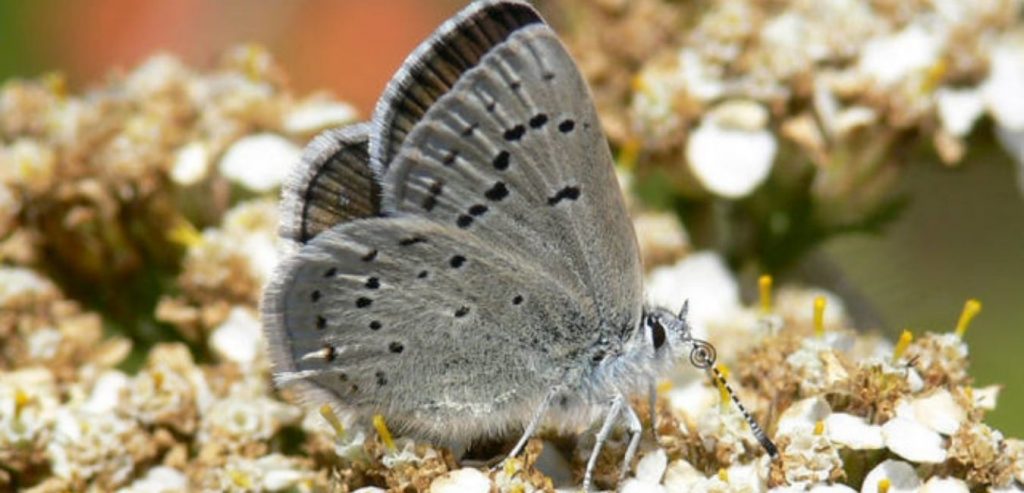Mission Blue

Mission Blue Butterfly’s PBC Earth Honoree 2022
With most of its grassland habitat lost to development, the mission blue (Icaricia icarioides missionensis) became one of the first insects was added to the Federal Endangered Species List in 1976, and is protected under the Endangered Species Act.
How to Recognize a Mission Blue
On the upperside of the wings, the adult female is brown with some blue, and the male is light blue. Both have blackish wing edges. The underside of the wings is off-white with two rows of irregularly shaped black spots. The larva (caterpillar) is light green with diagonal white bars on each segment.
Adults are about the size of a quarter (21–33 mm). Larvae are very small and rarely seen.
The mission blue butterfly is a unique subspecies of Boiduval’s blue butterfly that was first discovered in San Francisco in 1937. Light iridescent blue is a native of Bay Area grasslands that contain at least one of its three host plants: the silver lupine, the summer lupine, and the varied lupine.
Where to See and Find Them
Remaining populations of Mission blue butterfly are found in only a few locations around the San Francisco Bay area in California: the Marin Headlands (Marin County), the Skyline ridges (San Mateo County), San Bruno Mountain (San Mateo County), and at Twin Peaks (San Francisco County). The historical distribution of the species probably encompassed much of the coastal scrub/grassland habitat of the northern San Francisco peninsula and Marin County.
The Mission blue requires a larval host plant and appropriate nectar plants in a coastal grassland habitat. The host plants primarily utilized by the Mission blue are silver lupine (Lupinus albifrons) and summer lupine (Lupinus formosus). Nectar plants are varied, and often include several members of the sunflower family that grow in association with the lupines.
The Mission Blue’s Life Cycle
The eggs are usually laid singly on the dorsal side of new lupine leaves, but may also be laid on stems, flowers, and seed pods of the lupine. Eggs hatch within 6–10 days, and the first and second instar larvae feed on the mesophyll of the host plant. Approximately three weeks after eclosion, the second instar larvae begin diapause, usually in the litter at the base of the host plant. Diapause begins at about the same time that the host lupine shifts its energy from leaf maintenance to flower and seed production. Larvae remain in diapause for the rest of the summer and through the winter, and emerge to continue feeding in the spring. Pupation, which lasts about a week, occurs in the duff at the base of the host plant or other plants. The adult flight period lasts from March to June. Adults live for approximately one week, and females lay eggs on the host plant. The complete life cycle of the Mission blue lasts one year.
Mission blue larvae spend most of their time feeding on lupine leaves in a variety of weather conditions. Adults spend their short lives mating, laying eggs, and nectaring. To locate a mate, adults patrol around in patches of host plant, rarely straying far from the lupine habitat. On rainy, cool, windy, or foggy days, adults hide out underneath vegetation.
The Threats Are Real
Their grassland habitat and lupine host plants are also threatened, primarily by invasions of non-native trees and plants and by a lack of natural disturbances such as grazing and fire that would normally prevent scrubland from taking over the landscape. Additional ongoing threats to the mission blue’s survival include poaching, trampling, and climate change.
Also, the outbreak of an unknown fungal pathogen that infected lupine host plants during the El Nino year of 1998 at Milagra Ridge and Twin Peaks represents a threat to the mission blue butterfly throughout its range. Although many of the lupine host plant patches, and the mission blue butterfly population along with them, have reestablished themselves at Milagra Ridge and have been reestablished at Twin Peaks, the fungus remains present in the soil. The potential spread and outbreaks of this pathogen poses a greater threat to small and isolated populations.
Sources: parksconservancy.org, nps.gov, fws.gov
